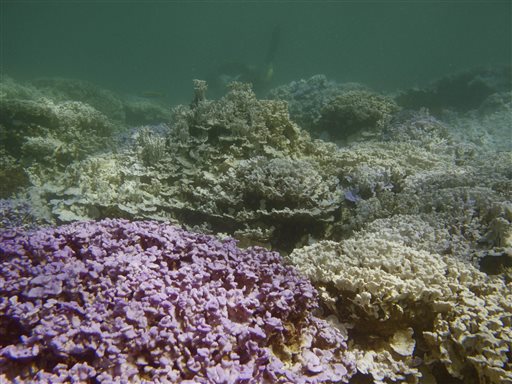
This 2014 photo provided by the National Oceanic and Atmospheric Administration and the Hawaii Institute of Marine Biology shows bleached coral at Lisianski Island in the Papahanaumokuakea Marine National Monument. The pale coral is bleached due to thermal stress, while the lavender-colored coral is healthy. AP
KANEOHE, Hawaii—While people in Hawaii have been sweating out a lack of trade winds, corals underwater are also suffering.
Scientists standing in the muggy heat at Heeia Small Boat Harbor in Kaneohe said Monday that they’re seeing more evidence that higher-than-normal ocean temperatures are causing near-shore bleaching across the islands.
The warm water prompts algae inside the coral to leave, which starves coral and turns it white.
It’s the same phenomenon causing mass bleaching that was detected about 1,000 miles (1,600 kilometers) northwest of Honolulu. The bleaching that crews have found along Oahu’s windward coast is especially severe, according to officials at Hawaii’s Department of Land and Natural Resources.
This September was the second-hottest on record since the 1940s, with recent underwater temperatures as high as 86 degrees Fahrenheit (30 degrees Celsius), scientists noted. A maximum of 83 degrees F (28.5 degrees C) is normal.
“It is fairly common to see some level of bleaching around this time of year,” said Anne Rosinski, marine resource specialist with the department’s Division of Aquatic Resources, explaining that the peak season is August to September. But “this is way above average from what we would expect.”
She said 75 percent of the dominant coral species surveyed in Kaneohe Bay showed signs of bleaching — starting to lose color or bleached completely white.
There also have been reports of coral bleaching on Maui, the Big Island and at Honolulu’s famed Hanauma Bay, a popular snorkeling spot, said Frazer McGilvray, administrator of the Aquatic Resources Division.
The warm temperature is adding to the stress factors coral already face, such as pollution, sediment in the water, invasive algae and being trampled upon.
“The corals are animals, right, they’re not rocks,” said Kim Hum, Hawaii Director of Marine Programs for The Nature Conservancy. “So what bleaching is, it’s a sign of distress.”
She said people need to “make our coral as healthy as possible … so that they can respond and they don’t bleach and they don’t die because of these additional stressors.”
The current bleaching event is more severe than the last one in 1996. Almost all of the coral recovered from the localized bleaching that occurred in the earlier part of that year. But the latest event is amid higher temperatures later in the year, said Ruth Gates, researcher at the Hawaii Institute of Marine Biology.
“And so, what we want is for the trade winds to return,” she said, so that the coral can rebound.
But the scientists said bleaching conditions will worsen in the next four to six weeks before the weather cools.